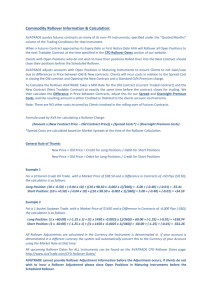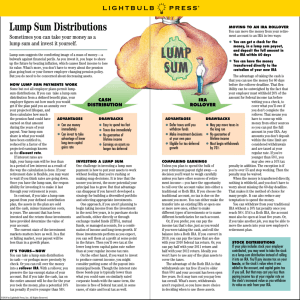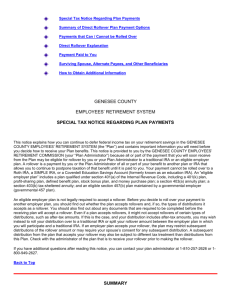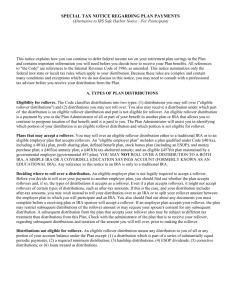Special Tax Notice - Firemen's Retirement System
advertisement
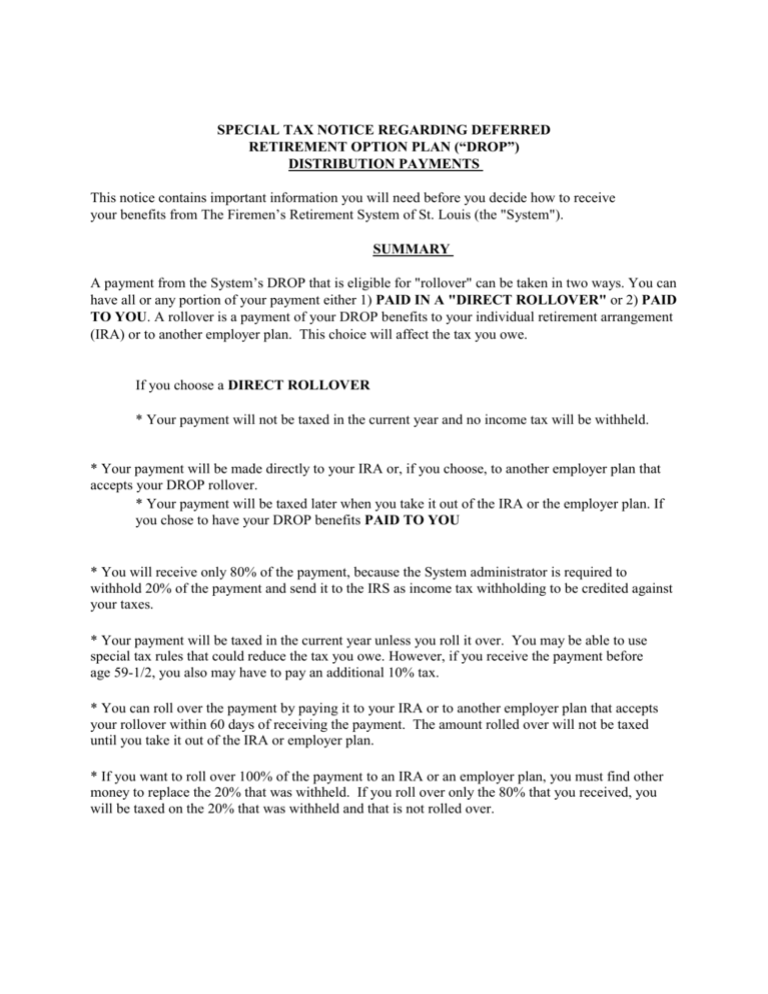
SPECIAL TAX NOTICE REGARDING DEFERRED RETIREMENT OPTION PLAN (“DROP”) DISTRIBUTION PAYMENTS This notice contains important information you will need before you decide how to receive your benefits from The Firemen’s Retirement System of St. Louis (the "System"). SUMMARY A payment from the System’s DROP that is eligible for "rollover" can be taken in two ways. You can have all or any portion of your payment either 1) PAID IN A "DIRECT ROLLOVER" or 2) PAID TO YOU. A rollover is a payment of your DROP benefits to your individual retirement arrangement (IRA) or to another employer plan. This choice will affect the tax you owe. If you choose a DIRECT ROLLOVER * Your payment will not be taxed in the current year and no income tax will be withheld. * Your payment will be made directly to your IRA or, if you choose, to another employer plan that accepts your DROP rollover. * Your payment will be taxed later when you take it out of the IRA or the employer plan. If you chose to have your DROP benefits PAID TO YOU * You will receive only 80% of the payment, because the System administrator is required to withhold 20% of the payment and send it to the IRS as income tax withholding to be credited against your taxes. * Your payment will be taxed in the current year unless you roll it over. You may be able to use special tax rules that could reduce the tax you owe. However, if you receive the payment before age 59-1/2, you also may have to pay an additional 10% tax. * You can roll over the payment by paying it to your IRA or to another employer plan that accepts your rollover within 60 days of receiving the payment. The amount rolled over will not be taxed until you take it out of the IRA or employer plan. * If you want to roll over 100% of the payment to an IRA or an employer plan, you must find other money to replace the 20% that was withheld. If you roll over only the 80% that you received, you will be taxed on the 20% that was withheld and that is not rolled over. I. II. III. IV. PAYMENTS THAT CAN AND CANNOT BE ROLLED OVER PAGE 2DIRECT ROLLOVER PAGE 2PAYMENT PAID TO YOU PAGE 3SURVIVING SPOUSES, AND OTHER BENEFICIARIES PAGE 6 I. PAYMENTS THAT CAN AND CANNOT BE ROLLED OVER Payments from the System’s DROP may be "eligible rollover distributions." This means that they can be rolled over to an IRA or to another employer plan that accepts rollovers. Your Plan administrator should be able to tell you what portion of your payment is an eligible rollover distribution. The following types of payments cannot be rolled over: Non-taxable Payments. In general, only the "taxable portion" of your payment is an eligible rollover distribution. If you have made "after-tax" member contributions to the Plan, these contributions will be non-taxable when they are paid to you, and they cannot be rolled over. (After-tax member contributions generally are contributions you made from your own pay that were already taxed.) Payments Spread Over Long Periods. You cannot roll over a payment if it is part of a series of equal (or almost equal) payments that are made at least once a year and that will last for your lifetime (or your life expectancy), or your lifetime or your beneficiary's lifetime (or life expectancies), or a period of ten years or more. Required Minimum Payments. Beginning in the year you reach age 70-1/2, a certain portion of your payment cannot be rolled over because it is a "required minimum payment" that must be paid to you. II. DIRECT ROLLOVER You can choose a direct rollover of all or any portion of your payment that is an "eligible rollover distribution," as described above. In a direct rollover, the eligible rollover distribution is paid directly from the Plan to an IRA or another employer plan that accepts rollovers. If you choose a direct rollover, you are not taxed on a payment until you later take it out of the IRA or the employer plan. Direct Rollover to an IRA. You can open an IRA to receive the direct rollover. (The term "IRA," as used in this notice, includes individual retirement accounts and individual retirement annuities.) If you choose to have your payment made directly to an IRA, contact an IRA sponsor (usually a financial institution) to find out how to have your payment made in a direct rollover to an IRA at that institution. If you are unsure of how to invest your money, you can temporarily establish an IRA to receive the payment. However, in choosing an IRA, you may wish to consider whether the IRA you choose will allow you to move all or a part of your payment to another IRA at a later date, without penalties or other limitations. See IRS Publication 590, Individual Retirement Arrangements, for more information on IRA's (including limits on how often you can roll over between IRA's). Direct Rollover to a Plan. If you are employed by a new employer that has a plan, and you want a direct rollover to that plan, ask the administrator of that plan whether it will accept your rollover. If your new employer's plan does not accept a rollover, you can choose a direct rollover to an IRA. Direct Rollover of a Series of Payments. If you receive eligible rollover distributions that are paid in a series for less than ten years, your choice to make or not make a direct rollover for a payment will apply to all later payments in the series until you change your election. You are free to change your election for any later payment in the series. III. PAYMENT PAID TO YOU If you have the payment made to you, it is subject to 20% income tax withholding. The payment is taxed in the year you receive it unless, within 60 days, you roll it over to an IRA or another plan that accepts rollovers. If you do not roll it over, special tax rules may apply. Income Tax Withholding: Mandatory Withholding. If any portion of the payment to you is an eligible rollover distribution, the Plan is required by law to withhold 20% of that amount. This amount is sent to the IRS as income tax withholding. For example, if your eligible rollover distribution is $10,000, only $8,000 will be paid to you because the Plan must withhold $2,000 as income tax. However, when you prepare your income tax return for the year, you will report the full $10,000 as a payment from the Plan. You will report $2,000 as tax withheld, and it will be credited against any income tax you owe for the year. Voluntary Withholding. If any portion of your payment is not an eligible rollover distribution but is taxable, the mandatory withholding rules described above do not apply. In this case, you may elect not to have withholding apply to that portion. To elect out of withholding, ask the Plan administrator for the election form and related information. Sixty-Day Rollover Option. If you have an eligible rollover distribution paid to you, you can still decide to roll over all or part of it to an IRA or another employer plan that accepts rollovers. If you decide to roll over, you must make the rollover within 60 days after you receive You can roll over up to 100% of the eligible rollover distribution, including an amount equal to the 20% that was withheld. If you choose to roll over 100%, you must find other money within the 60day period to contribute to the IRA or the employer plan to replace the 20% that was withheld. On the other hand, if you roll over only the 80% that you received, you will be taxed on the 20% that was withheld. Example: Your eligible rollover distribution is $10,000, and you choose to have it paid to you. You will receive $8,000, and $2,000 will be sent to the IRS as income tax withholding. Within 60 days after receiving the $8,000, you may roll over the entire $10,000 to an IRA or employer plan. To do this, you roll over the $8,000 you received from the Plan, and you will have to find $2,000 from other sources (your savings, a loan, etc.). In this case, the entire $10,000 is not taxed until you take it out of the IRA or employer plan. If you roll over the entire $10,000, when you file your income tax return you may get a refund of the $2,000 withheld. If, on the other hand, you roll over only $8,000, the $2,000 you did not roll over is taxed in the year it was withheld. When you file your income tax return you may get a refund of part of the $2,000 withheld. (However, any refund is likely to be larger if you roll over the entire $10,000.) Additional 10% Tax If You Are Under Age 59-1/2. If you receive a payment before you reach 59-1/2 and you do not roll it over, then, in addition to the regular income tax, you may have to pay an extra tax equal to 10% of the taxable portion of the payment. The additional 10% tax does not apply to your payment if it is (1) paid to you because you separate from service with your employer during or after the year you reach age 55, (2) paid because you retire due to disability, (3) paid to you as equal (or almost equal) payments over your life or life expectancy (or your and your beneficiary's life or life expectancies), or (4) used to pay certain medical expenses. See IRS Form 5329 for more information on the additional 10% tax. Special Tax Treatment. If your eligible rollover distribution is not rolled over, it will be taxed in the year you receive it. However, if it qualifies as a "lump sum distribution," it may be eligible for special tax treatment. A lump sum distribution is a payment, within one year, of your entire balance under the Plan (and certain other similar plans of the employer) that is payable to you because you have reached age 59-1/2 or have separated from service with your employer (or, in the case of a selfemployed individual, because you have reached age 59-1/2 or have become disabled). For a payment to qualify as a lump sum distribution, you must have been a participant in the Plan for at least 5 years. The special tax treatment for lump sum distributions is described below. Ten-Year Averaging If You Were Born Before January 1, 1936. If you receive a lump sum distribution and you were born before January 1, 1936, you can make a one-time election to figure the tax on the payment by using "10-year averaging" (using 1986 tax rates), 10-year averaging often reduces the tax you owe. Capital Gain Treatment If You Were Born Before January 1, 1936. In addition, if you receive a lump sum distribution and you were born before January 1, 1936, you may elect to have the part of your payment that is attributable to your pre-1974 participation in the Plan (if any) taxed as long-term capital gain at a rate of 20%. There are other limits on the special tax treatment for lump sum distributions. For example, you can generally elect this special tax treatment only once in your lifetime, and the election applies to all lump sum distributions that you receive in that same year. If you have previously rolled over a payment from the Plan (or certain other similar plans of the employer), you cannot use this special tax treatment for later payments from the Plan. If you roll over your payment to an IRA, you will not be able to use this special tax treatment for later payments from the IRA. Also, if you roll over only a portion of your payment to an IRA, this special tax treatment is not available for the rest of the payment. Additional restrictions are described in IRS Form 4972, which has more information on lump sum distributions and how you elect the special tax treatment. IV. SURVIVING SPOUSES AND OTHER BENEFICIARIES In general, the rules summarized above that apply to payments to members also apply to payments to surviving spouses of members. Some of the rules summarized above also apply to a deceased member's beneficiary who is not a spouse. However, there are some exceptions for payments to surviving spouses and other beneficiaries that should be mentioned. If you are a surviving spouse, you may choose to have an eligible rollover distribution paid in a direct rollover to any IRA or paid to you. If you have the payment paid to you, you can keep it or roll it over yourself to an IRA but you cannot roll it over to an employer plan. If you are a beneficiary other than the surviving spouse, you can choose a direct rollover but you cannot roll over the payment yourself. If you are a surviving spouse or another beneficiary, your payment is not subject to the additional 10% tax described in section III above, even if you are younger than age 59-1/2. HOW TO OBTAIN ADDITIONAL INFORMATION This notice summarizes only the federal (not state or local) tax rules that might apply to your payment. These rules described above are complex and contain many conditions and exceptions that are not included in this notice. Therefore, you may want to consult with a professional tax advisor before you take a payment of your benefits from the Plan. Also, you can find more specific information on the tax treatment of payments from qualified retirement plans in IRS Publication 575, Pension and Annuity Income, and IRS Publication 590, Individual 285320.wpd -6

